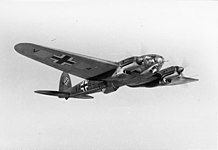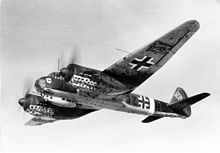Heinkel-Werke Oranienburg
The Heinkel-Werke Oranienburg (HWO, 1935–1948) were an important armaments factory in Oranienburg , Germendorf and Berlin-Reinickendorf during the National Socialist era . The plant was part of the Ernst Heinkel Flugzeugwerke in Rostock . In the plant, which was essentially built from 1936 to 1938, combat aircraft such as the Heinkel He 111 , the Heinkel He 177 and the Junkers Ju 88 were manufactured for the Air Force . The plant also included the two newly built White City settlements in Oranienburg and Leegebruch . On April 1, 1943, the name changed to Ernst Heinkel AG Werk Oranienburg. After the end of the Second World War , the actual plant was completely demolished except for the works airfield , a hall and smaller ancillary buildings. There and partly in the White City housing estate in Oranienburg, the Red Army built a military airfield and barracks. Since the withdrawal of the Soviet troops, the area has been gradually converted into civilian use.
prehistory
After the National Socialists came to power, secret preparations began in the German Reich to build an air force, which at that time was still forbidden due to the Treaty of Versailles . On March 1, 1935, Hermann Göring , the Reich Minister for Aviation, officially exposed the new air force. At that time, Ernst Heinkel Flugzeugwerke GmbH was producing the Heinkel He 111 fighter aircraft in Rostock under its founder Ernst Heinkel . This aircraft was to become the standard equipment of the new combat squadrons, so production had to be increased. Since the production capacities in Rostock were exhausted, the Reich Aviation Ministry (RLM) looked for suitable locations for a new plant near Berlin . On March 18, 1935, the RLM decided on the Oranienburg and Germendorf locations. On May 1, 1935, Heinkel-Werke GmbH Oranienburg was officially founded with a share capital of RM 5 million . The RLM held 97% of the shares, while the rest was held by Ernst Heinkel. The plant was de facto a state-owned company until the end of 1939, but left Ernst Heinkel with extensive competencies. Then he took over the shares in the RLM for 17.95 million RM.
Planning and implementation
A group of up to 25 architects was responsible for the planning and implementation, with the architect Herbert Rimpl as the main person in charge . Other architects responsible for individual areas were Joseph Bernhard, Norbert Schlesinger , Georg Leowald , Bernhard Hermkes , Walter Tralau and Wilhelm Heintz .
On May 4, 1936, construction work began to implement the building plans, which culminated in the opening ceremony on May 4, 1937. Plant I ( Lage ), also called Oberwerk, was planned by Rimpl in the Germendorfer Forest west of Veltener Strasse on the outskirts of Germendorf. Eight standardized halls were built there on an area of 110 hectares (warehouse, partial building I, partial building II, fuselage construction, central section construction, surface construction, tail unit construction and pre-assembly), various smaller workshop buildings, plus a representative administration building with canteen and a health center with sports hall and swimming pool. A training workshop and a dormitory were available for apprenticeship training. Smaller buildings for the plant security, the plant fire brigade and the porter's office were arranged in the entrance area.
Plant II ( Lage ), also known as substation, was to be built with the works airfield in Oranienburg-Annahof on Bärenklauer Weg. There were two halls on 70 hectares (final assembly and fly-in with adjustment function shooting range) as well as further supply structures and the works airfield.
A new road was built to connect the two plants. After the completion of the street (today's Annahofer Straße) it quickly had the popular name Heinkelchaussee, which is still used today . Works I and II were connected to the tracks of the Nauen – Oranienburg railway line . The siding to Plant I branched off shortly after the Oranienburg-Eden train station and then ran parallel to Heinkelchaussee , with which it shared a bridge over Veltener Straße in Germendorf.
Richthofenstraße (today's Walther Bothe Straße) ran from Plant II in the direction of Oranienburg to the newly built white town ( Lage ). There 662 apartments were built in 18 apartment blocks. In the factory settlement Leegebruch ( location ), which was built around an existing village core, created in 1206 dwellings in single and double houses, and six Single dormitories, twelve shops, a community center and a school. Both factory settlements were not completely completed due to the war.
Plant III ( location ) was built in Berlin-Reinickendorf at Flottenstrasse 21–23 . On an area of around 40,000 m², the employees produced stamped and molded parts, which were then installed in the other two plants.
Gut Annahof ( location ), which was located between Plant I and Plant II, was included in the production of food for the plant canteen. The total construction costs of all the measures described above amounted to 45.8 million RM.
|
Plant management Plant director: Erich Koch Assistant: Kurt Schmidt |
|
Commercial Department I Commercial Director: Hermann Ungemach |
Commercial Division II Commercial Director: Hans Eichler |
Technical area Technical manager: Otto Barchfeld |
HR department | Legal Department | Security and security | Apprenticeship training | Company doctor | Good annahof | Forestry |
| Revision | sale | Work maintenance | Plant security | Training workshop | |||||
| General Ledger Accounting | Purchasing | Kovoba I | Air raid | professional school | |||||
| Asset accounting | Inventory accounting | Kovoba II | Fire protection | Apprentice dormitory | |||||
| Current account accounting | Warehousing / warehouse | Operational planning | |||||||
| Operational accounting | Preliminary calculation | ||||||||
| Billing center | Post calculation | ||||||||
| Pay office | Part I | ||||||||
| Remittance office | Part II | ||||||||
| Main checkout | Hull construction | ||||||||
| Housing benefit office | Middle piece construction | ||||||||
| Surface construction | |||||||||
| Tail construction | |||||||||
| Pre-assembly | |||||||||
| Final assembly | |||||||||
| Flying in |
production
In the first few years, the workforce exclusively manufactured the Heinkel He 111. For this purpose, the workers in the halls parts I and II formed and cut sheet metal and spar profiles that went to the areas of fuselage, center piece, surface and tail unit construction. There, each area manufactured the part intended for it, which was then assembled into the finished aircraft in the pre-assembly hall, with the exception of the wings. Then tractors drove the aircraft - the finished wings separately - to Plant II, where it was completed in the final assembly hall. Some parts - such as the on-board weapons - were supplied by the Ikaria company for aircraft accessories from nearby Velten . It was then tested in terms of flight technology in the fly-in hall, before factory pilots carried out a total of three test flights per aircraft. Then it was taken over by the Air Force.
Series production of the factory began in April 1937 with 16 delivered Heinkel He 111-B2s. The other stages of development were also manufactured here. Production of the He 111-H series began in 1939 and ran with small changes until 1943. A total of 2216 Heinkel He 111 were produced in Germendorf and Oranienburg. After 15 Heinkel He 177 A-0s had been manufactured in the winter of 1940/41, series production of the He 177 A-3s only started in the factory one year later. By October 1944, 288 He 177s had been built. From December 1940 to July 1942 Heinkel also manufactured 708 Junkers Ju 88s under license. When the RLM decided on June 28, 1944, due to the war, not to build any more combat aircraft, the plant manufactured components for the Focke-Wulf Fw 190 and the Fieseler Fi 103 (better known as V1). Assemblies supplied by other plants were also put together to form complete Focke-Wulf Fw 190s. At the same time, preparations were made for series production of the Dornier Do 335 , which was only delivered once until the end of the war.
Despite the outstanding position of the plant, US bomber groups attacked Plant I for the first time on April 18, 1944. On April 10, 1945, the works airfield and Plant II were attacked. These two air raids did not cause any significant damage to production, which was ultimately only ended on 22/23. April 1945 Soviet and Polish soldiers occupied the plant.
Employees
When planning the plant and production, a workforce of 8,000 to 10,000 people was expected. In November 1938, about one and a half years after the start of series production, only 7,360 people were employed. Since not all workers - especially the necessary skilled workers - could be obtained from the region, the Heinkel works advertised throughout the German Empire . Eventually people from the Rhineland, Westphalia, Silesia, Saxony, Hamburg, Saarland and Ostmark (Austria) moved into the two factory settlements. In its eight years of existence, the plant also trained at least 1,040 apprentices itself. For foreign apprentices, there was a dormitory with 70 places in Plant I.
From the end of 1939, the first prisoners of war came to the plant as workers. A wooden barracks camp ( Lage ) was built for them on Veltener Straße in the immediate vicinity of Plant I , which was continuously expanded in the following years. At its heyday, 3,000 foreign workers lived here, either prisoners of war or forced labor from Poland, Holland, France, Yugoslavia, Greece, the Soviet Union or Italy. Another camp for forced laborers was located on Alte Heerstrasse (today Hildburghauser Strasse) in Oranienburg-Süd from July 1942. There, space for up to 2500 forced laborers was created in 28 barracks. Smaller contingents of foreign workers also came from other camps in the area.
From March 1942, prisoners from the nearby Sachsenhausen concentration camp began working in production. These were initially temporarily housed in the cellars of the buildings in Plant I. At least since March 1943 was built on the site of the work I, a sub-camp of wooden barracks . The first camp manager was SS-Hauptsturmführer Johannes Hassebroek . In February 1944, 5,939 prisoners were employed at the plant. In June 1944, the highest number of prisoners was reached with 6966 prisoners. Most of the prisoners came from the Soviet Union, France and Poland, but smaller contingents also came from Norway, Belgium and Spain and Germany. The only momentous air attack by US bombers on Plant I killed 106 prisoners, among others.
With the addition of prisoners of war, forced laborers and concentration camp inmates, the total number of workers increased further. While only 7,585 people worked here in April 1940, this number rose to 11,004 in March 1942 and finally reached its all-time high in September 1943 with 14,215 people. The number of German employees fell from 80 to 38 percent from March 1942 to June 1944.
After the war
On the basis of orders No. 124 and 126 of the Soviet military administration, German workers carried out the complete dismantling of the eight-year-old factory. Only in Plant II did the fly-in hall, some outbuildings and the works airfield remain, which were combined with parts of the White City to form a Red Army barracks. On July 23, 1948, the new government of the state of Brandenburg expropriated the Heinkel-Werke Oranienburg and on October 13, 1948 the work was officially deleted from the commercial register of the Oranienburg District Court . The siding to Plant I was extended to Velten in 1951 and the new Oranienburg – Velten railway was opened.
Traces of the past
Today only a few traces of the former Heinkel works in Oranienburg are left. Not a single building of the former Plant I in the Germendorfer Forest has been preserved above ground. The property is used as a commercial area by various companies. The siding to Plant I has been removed. Only the embankment and some sleepers are partially visible. Today, Heinkelchaussee is open to public traffic as Annahofer Straße. Instead of the forced labor camp, there is now a pine forest, under the floor of which the foundations of the barracks should still be found.
After the withdrawal of the Red Army, the former Plant II with the works airfield was converted into an industrial park in which the Cologne trading group Rewe operates a logistics center. There, too, 33,154 solar modules are set up on an area of 17 hectares. Since August 2011, the plant has been producing 7.79 megawatts of electricity at best. In the long term, all of the buildings still in existence - with the exception of the former fly-in hall, which is a listed building - will be demolished. The bypass of the federal highway 96 north of the Autobahn triangle Kreuz Oranienburg has touched the former works airfield since 2003, the concrete runways of which were removed in 2010.
In 2011 there is only an administration building of Plant III at Flottenstrasse 21–23 in Berlin-Reinickendorf.
The former white city housing estate in Oranienburg was extensively renovated after the withdrawal of the Red Army and the apartments were rented out. In the former Leegebruch factory estate, gaps in the development were closed after 1990 with new residential areas. However, the typical character of the former factory estate with its single and double houses has been preserved.
Former fly-in hall in Plant II ( location )
Building of the former plant fire brigade in Plant II ( location )
Branch (left) of the former works connection from the former Oranienburg-Kremmen railway line (right) at km 32.4 ( Lage )
literature
- Norbert Rohde : Historical military objects of the Oberhavel region. Volume 1: The Heinkel aircraft factory in Oranienburg. Velten Verlag GmbH, Leegebruch 2006, ISBN 3-9811401-0-9 .
- Jürgen Thorwald (Ed.), Ernst Heinkel: Stormy life. European Book Club, Stuttgart / Zurich / Salzburg (around 1954).
- Hermann Mäckler: A German aircraft factory. The Heinkel-Werke Oranienburg, architect Herbert Rimpl. Wiking-Verlag, Berlin (1939/1940).
- Hans Dieter Köhler: Ernst Heinkel. Pioneer of high-speed aircraft. Bernard & Graefe, Koblenz 1983, ISBN 3-7637-5281-1 .
- Lutz Budraß : Aircraft Industry and Air Armament in Germany 1918–1945. 2nd edition, Droste Verlag, Düsseldorf 2007, ISBN 978-3-7700-1623-5 .
- Roman Fröhlich: The prisoner deployment was ordered. Scope for action when using prisoners of the Sachsenhausen concentration camp in the Heinkel aircraft factory Oranienburg , Metropol Verlag , Berlin, 2018, ISBN 978-3-86331-386-9 . (Dissertation)
Web links
Individual evidence
- ↑ Lutz Budraß, p. 495 ff.
- ↑ Norbert Rohde, p. 50.
- ↑ Norbert Rohde, p. 155.
- ↑ Norbert Rohde, p. 140.
- ↑ Lutz Budraß, p. 497 ff.
- ↑ Hans Dieter Köhler, p. 124.
- ↑ Norbert Rohde, p. 74.
- ↑ Norbert Rohde, p. 70.
- ↑ Lutz Budraß, p. 873.
- ↑ Lutz Budraß, p. 351.
- ↑ Norbert Rohde, p. 125.
- ^ Jens W. Kleist: Camp in Oranienburg 1933-1945. Retrieved April 29, 2011.
- ↑ Norbert Rohde, p. 131.
- ↑ a b Wolfgang Benz , Barbara Distel (Ed.): The place of terror . History of the National Socialist Concentration Camps. Volume 3: Sachsenhausen, Buchenwald. CH Beck, Munich 2006, ISBN 3-406-52963-1 , p. 245.
- ↑ Norbert Rohde, p. 130.
- ↑ Oranienburger Generalanzeiger of June 24, 2011, p. 2.














